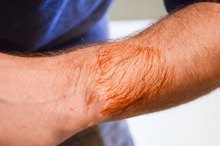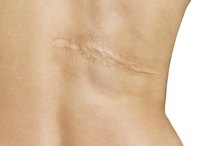How to Go Back to Original Skin Color After Bleaching
The use of skin bleaching to reduce dark spots due to aging, sun exposure, medications or pollution is an option for returning skin to its original coloration. Hyper pigmentation, or increased melanin production--resulting in darker patches of skin--is also a reason for skin bleaching. The process has been linked to controversy by certain ethnic groups seeking to lighten the skin’s appearance and appear whiter. Skin bleaching procedures can take a few weeks or up to a year or more to show results. Reversing the affects of skin bleaching can be just as lengthy.
Discontinue the use of any skin bleaching procedures. To reverse the effects, the process should be halted and an evaluation of the skin undertaken. Visually inspect skin for current condition and coloration in regard to overall skin tone. If skin damage has occurred during the skin bleaching treatments, consult a medical professional to assess short- or long-term effects.
Can Damaged Collagen Naturally Restore Itself?
Learn More
Expose skin to sunlight 2. Sunlight may naturally halt or reverse the skin bleaching process. The skin will begin to absorb ultraviolet rays from the sun and begin darkening the skin in areas where bleaching occurred. Bleaching reduces the body’s production of melanin, the substance that makes skin appear darker. Sun exposure encourages the production of melanin in the skin. It is recommended that skin protection be used whenever skin is exposed to the sun.
Contact a professional dermatologist for assistance in monitoring the skin bleaching reversal process. Additional options to reverse the effects may be available through skin care specialist like a dermatologist. A professional can also provide insight into progress during the reversal process.
Warnings
Many skin bleaches contain mercury and hydroquinone as main ingredients. These chemicals are toxic and can result in long-term health issues, including cancer and thyroid conditions. Severe damage such as scarring, acne and extreme skin discoloration created by the use of skin-bleaching products can be irreversible.
Related Articles
References
- Kanitakis J. Anatomy, histology and immunohistochemistry of normal human skin. Eur J Dermatol. 2002 Jul-Aug;12(4):390-9.
- Habif TP. Clinical Dermatology E-Book. 5th ed. Elsevier Health Sciences; 2009.
- Dutton J, Gayre G, Proia A. Diagnostic Atlas of Common Eyelid Diseases. New York: Taylor & Francis Ltd.; 2007:1. doi:10.3109/9781420016321
- Alberts B, Johnson A, Lewis J, Raff M, Roberts K, Walter P. Molecular Biology of the Cell, 4th ed. New York: Garland Science; 2002.
- Kakasheva-Mazhenkovska L, Milenkova L, Gjokik G, Janevska V. Variations of the histomorphological characteristics of human skin of different body regions in subjects of different age. Prilozi. 2011;32(2):119-28.
- Sandby-Møller J, Poulsen T, Wulf HC. Epidermal thickness at different body sites: relationship to age, gender, pigmentation, blood content, skin type and smoking habits. Acta Derm Venereol. 2003;83(6):410-3. doi:10.1080/00015550310015419
- Rahrovan S, Fanian F, Mehryan P, Humbert P, Firooz A. Male versus female skin: What dermatologists and cosmeticians should know. Int J Womens Dermatol. 2018 Jun 22;4(3):122-130. doi:10.1016/j.ijwd.2018.03.002
Warnings
- Many skin bleaches contain mercury and hydroquinone as main ingredients. These chemicals are toxic and can result in long-term health issues, including cancer and thyroid conditions. Severe damage such as scarring, acne and extreme skin discoloration created by the use of skin-bleaching products can be irreversible.
Writer Bio
Pamela Raymond, owner of The Raymond Experience, a firm specializing in public relations and event management, has been a published freelance writer for over 14 years with articles in Sauce Magazine, Uptown Magazine, Vital Voice and ALIVE Magazine and holds an MBA from Maryville University in St. Louis.









